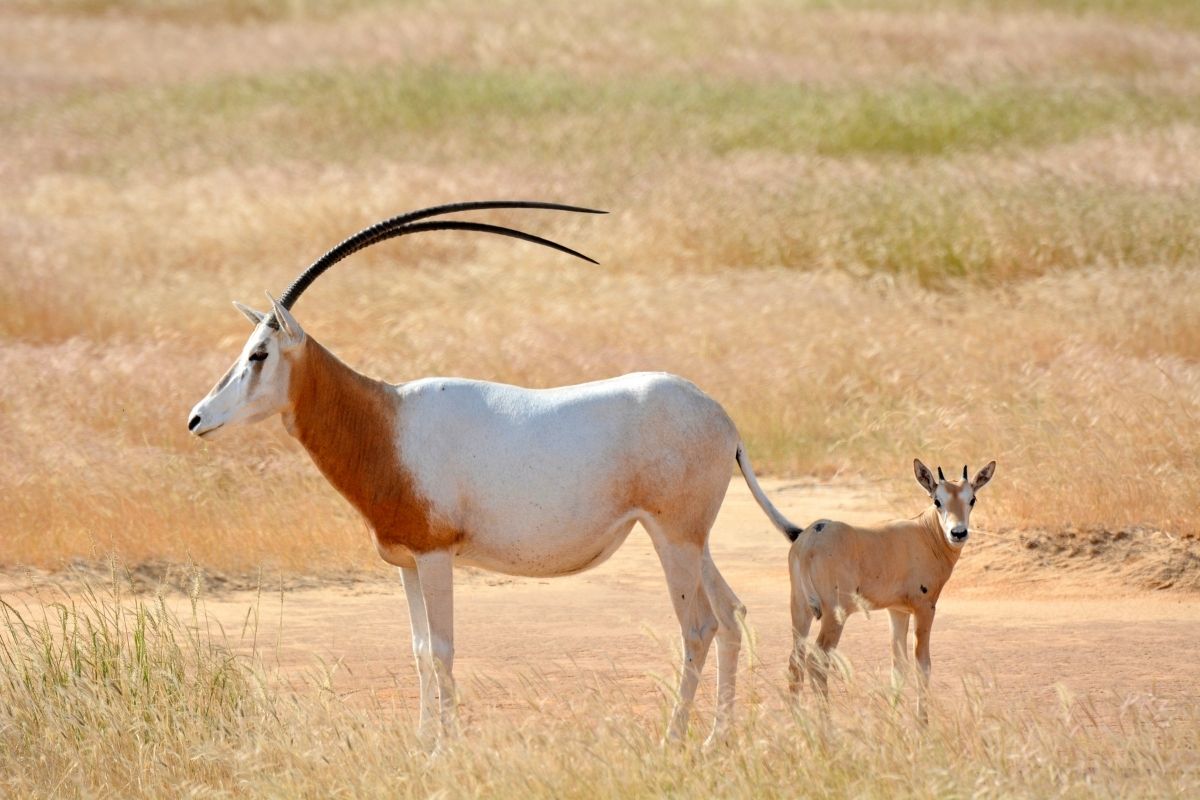by Bill Clark
Last year’s plentiful rains in the Senegalese Ferlo of West Africa were cause for celebration as nature flourished and produced a great abundance of vegetation. Villagers danced in the rain and splashed around in the puddles.
Alongside the villages, the sprawling Ferlo North Wildlife Reserve, a restored, protected, enclosed habitat free from livestock, made possible by a partnership between Friends of Animals (FoA) and Senegal’s National Parks Directorate, also reaped the benefits of last year’s rain. The rain stimulated a spectacular recovery of Zornia glochidiata, one of the most important herbs of the entire African Sahel, along with a variety of savanna grasses and Sahelian trees, such as acacia, balsam, rosewood and baobab.
And that’s another reason to rejoice because the restored vegetation is allowing FoA’s scimitar-horned oryx reintroduction project to take a big step forward. FoA is depending on the vegetation, especially the zornia, a legume related to peas, beans, lentils and alfalfa that has important nutritional value, to feed a test population of 15 critically endangered oryxes. The bachelor males will be released to an unsecure 12,355-acre area adjacent to their current smaller, secure 3,000- acre enclosure.
By “secure” we mean the smaller enclosure is predator-proof. It effectively keeps the jackals and hyenas who live in the region away from habitat where oryxes and gazelles give birth to their calves—a favored prey of these carnivores.
Back in 1999, FoA worked with the Israel Nature and Parks Authority to deliver eight scimitar-horned oryxes to Senegal and provided instruction to rangers on how to take care of them. The Senegalese clearly learned their lessons as the oryx population today is robust, healthy and exceeds 550 individuals.
Ultimately, wild animals must be able to live with all natural risks, including predation. But for the moment, we’re exposing the oryxes to these risks in a careful and controlled manner.
The jackals and hyenas are unlikely to attack the 15 healthy adult male oryxes, so we’ll let this pioneer group establish a presence inside the larger area before releasing the more vulnerable females and young. We’re providing the young bulls with opportunity to become aware of the carnivores and learn how to chase them away before making them responsible for the defense of oryx herds that include more vulnerable animals. Once more of the habitat has been rehabilitated, all the scimitar-horned oryxes can be released to complete freedom in the 1,880 square mile wildlife reserve.
Restoring habitat is not only important to wildlife like the oryxes, but it can also assist with global issues such as the climate crisis and biological diversity.
Vegetation in restored habitats uses photosynthesis to extract carbon dioxide from the atmosphere and store that carbon inside the cellular structure of those plants. Barren, over-grazed landscapes can’t do that.
Habitat rehabilitation carries some risks. The most conspicuous risk is wildfire. Most vegetation is combustible, and precautions to prevent fire are very important, especially in the Ferlo where the weather is very dry and hot for at least nine months every year.
FoA is grateful to Taiwan’s Forestry Bureau, which is providing a grant to help clear about 54 miles of firebreaks within Ferlo North Wildlife Reserve, and also excavate some of the natural ponds clogged by wind-eroded silt. Both efforts will help restore and protect the natural ecology of the reserve.
Zornia, like other legumes, is a “nitrogen-fixing” herb. It absorbs nitrogen from the air and “fixes” it into the soil, thereby making the soil more fertile. Zornia is also a superb soil “binder.” It has a dense network of fine roots that effectively stabilize the soil and protect it from wind and water erosion.
For decades, climatologists have been warning climate change will cause real suffering, especially in the African Sahel. They have evidence that, on average, the annual amount of rainfall there is diminishing. Average temperatures are increasing. Winds are stronger, and they’re scooping up more exposed, overgrazed topsoil. This year’s rains arrived later and were more sparse.
Despite clear signs of climate change and the fact that animal farming is responsible for 14% of global carbon emissions, all villages neighboring Ferlo North Wildlife Reserve, except Katane village, still manage the same high numbers of livestock.
The Katane village, a Fulani community of 312 people, agreed to reduce the size of cow, goat and sheep herds in exchange for an FoA-sponsored vegetable garden, and they are no longer suffering the intense impact of heavy grazing on their land and are less effected by the fluctuations of rainfall. FoA’s partnership with Katane flows mostly via the village women’s cooperative. They’re the ones who tend the village garden and deliver drinking water daily to the wildlife reserve. They’re the ones FoA helped earlier this year when the village’s sole water pump broke down and needed urgent repair. This partnership demonstrates that one way to help wildlife abroad is to work with the local communities who share the landscape.
FoA’s intent is to make the Katane model attractive to neighboring villages to benefit humans and wildlife and to combat the climate crisis. The good news is, the idea is catching on, and each village has expressed interest.

